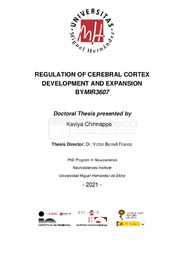Por favor, use este identificador para citar o enlazar este ítem:
https://hdl.handle.net/11000/29321
Regulation of cerebral cortex development and expansion by MiR3607
Título :
Regulation of cerebral cortex development and expansion by MiR3607 |
Autor :
Chinnappa, Kaviya |
Tutor:
Borrell Franco, Victor |
Editor :
Universidad Miguel Hernández |
Departamento:
Instituto de Neurociencias |
Fecha de publicación:
2021-12-16 |
URI :
https://hdl.handle.net/11000/29321 |
Resumen :
MicroRNAs (miRNAs) are a class of non-coding RNA molecules increasingly recognized to play varied roles in development, physiology and disease. The majority of miRNAs are expressed in the brain, have fast turnover rates and the ability to regulate several genes in a spatio-temporal fashion. This makes them important regulators of gene expression during the extraordinarily complex process of brain development. The identification that novel miRNAs emerged during speciation in mammalian evolution helps to understand their importance and roles in the developmental processes leading to the formation of folded brains with increasing complexity in higher mammals. Our previous transcriptomic analyses of the developing ferret cortex identified candidate genes and miRNAs differentially expressed across germinal layers, with potential relevance in cerebral cortex expansion. We identified MIR3607 as highly and differentially expressed between embryonic germinal layers of the large and folded human and ferret cortex, but not expressed in the lissencephalic small mouse cortex. Experimental expression of MIR3607 in the developing cerebral cortex of mouse embryos at E14.5 affected neurogenesis, and transcriptomic profiling revealed increased Wnt/βCatenin signaling and decreased apical adhesion as the major underlying factors. Expression of MIR3607 at E12.5, when progenitor cells expand, dramatically effected amplification and delamination of apical progenitors, as predicted, leading to rosette formation. This was rescued by co-expressing Adenomatous Polyposis Coli (APC), repressor of canonical Wnt signaling and a direct target of MIR3607. A similar phenotype was produced in human cerebral organoids, indicating the conservation of this function. Experiments of loss of MIR3607 function in ferret severely impaired polarity of apical progenitor cells and induced their delamination and ectopic mitosis, defects phenocopied by overexpressing APC. Our findings demonstrate that MIR3607 activates Wnt/βCatenin signaling in apical progenitor cells, promoting their amplification and the sustained expansion of the Ventricular Zone to form a large and complex cerebral cortex in higher mammals.
|
Palabras clave/Materias:
Nerociencias |
Área de conocimiento :
CDU: Ciencias aplicadas: Medicina: Patología. Medicina clínica. Oncología: Neurología. Neuropatología. Sistema nervioso |
Tipo de documento :
info:eu-repo/semantics/doctoralThesis |
Derechos de acceso:
info:eu-repo/semantics/openAccess |
Aparece en las colecciones:
Tesis doctorales - Ciencias de la Salud
|
 La licencia se describe como: Atribución-NonComercial-NoDerivada 4.0 Internacional.
La licencia se describe como: Atribución-NonComercial-NoDerivada 4.0 Internacional.
 La licencia se describe como: Atribución-NonComercial-NoDerivada 4.0 Internacional.
La licencia se describe como: Atribución-NonComercial-NoDerivada 4.0 Internacional.
.png)
